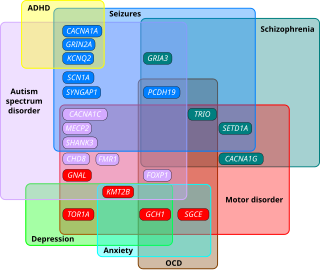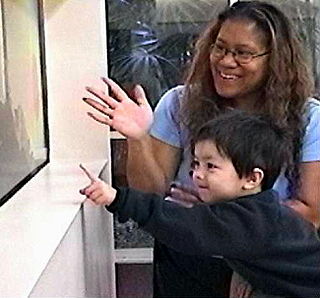
Asperger syndrome (AS), also known as Asperger's syndrome or Asperger's, is a diagnostic label that has been used to describe a neurodevelopmental disorder characterized by significant difficulties in social interaction and nonverbal communication, along with restricted, repetitive patterns of behavior and interests. Asperger syndrome has been merged with other conditions into autism spectrum disorder (ASD) and is no longer a diagnosis in the WHO's ICD-11 or the APA's DSM-5-TR. It was considered milder than other diagnoses which were merged into ASD due to relatively unimpaired spoken language and intelligence.
The diagnostic category pervasive developmental disorders (PDD), as opposed to specific developmental disorders (SDD), was a group of disorders characterized by delays in the development of multiple basic functions including socialization and communication. It was defined by the Diagnostic and Statistical Manual of Mental Disorders (DSM), and the International Classification of Diseases (ICD).
Developmental disorders comprise a group of psychiatric conditions originating in childhood that involve serious impairment in different areas. There are several ways of using this term. The most narrow concept is used in the category "Specific Disorders of Psychological Development" in the ICD-10. These disorders comprise developmental language disorder, learning disorders, developmental coordination disorders, and autism spectrum disorders (ASD). In broader definitions, attention deficit hyperactivity disorder (ADHD) is included, and the term used is neurodevelopmental disorders. Yet others include antisocial behavior and schizophrenia that begins in childhood and continues through life. However, these two latter conditions are not as stable as the other developmental disorders, and there is not the same evidence of a shared genetic liability.
Childhood disintegrative disorder (CDD), also known as Heller syndrome and disintegrative psychosis, is a rare condition characterized by late onset of developmental delays—or severe and sudden reversals—in language, social engagement, bowel and bladder, play and motor skills. Researchers have not been successful in finding a cause for the disorder. CDD has some similarities to autism and is sometimes considered a low-functioning form of it. In May 2013, CDD, along with other sub-types of PDD, was fused into a single diagnostic term called "autism spectrum disorder" under the new DSM-5 manual.
Diagnoses of autism have become more frequent since the 1980s, which has led to various controversies about both the cause of autism and the nature of the diagnoses themselves. Whether autism has mainly a genetic or developmental cause, and the degree of coincidence between autism and intellectual disability, are all matters of current scientific controversy as well as inquiry. There is also more sociopolitical debate as to whether autism should be considered a disability on its own.

Autism spectrum disorder (ASD) or simply autism is a neurodevelopmental disorder that begins in early childhood, persists throughout adulthood, and is characterized by difficulties in social communication and restricted, repetitive patterns of behavior. There are many conditions comorbid to autism, such as attention deficit hyperactivity disorder, anxiety disorders, and epilepsy.
Ole Ivar Løvaas was a Norwegian-American clinical psychologist and professor at the University of California, Los Angeles. He is most well known for his research on what is now called applied behavior analysis (ABA) to teach autistic children through prompts, modeling, and positive reinforcement. His application of the science was also noted for its use of aversives (punishment) to reduce undesired behavior, which are no longer supported as a part of most ABA treatment plans.
Discrete trial training (DTT) is a technique used by practitioners of applied behavior analysis (ABA) that was developed by Ivar Lovaas at the University of California, Los Angeles (UCLA). DTT uses mass instruction and reinforcers that create clear contingencies to shape new skills. Often employed as an early intensive behavioral intervention (EIBI) for up to 25–40 hours per week for children with autism, the technique relies on the use of prompts, modeling, and positive reinforcement strategies to facilitate the child's learning. It previously used aversives to punish unwanted behaviors. DTT has also been referred to as the "Lovaas/UCLA model", "rapid motor imitation antecedent", "listener responding", "errorless learning", and "mass trials".
High-functioning autism (HFA) was historically an autism classification to describe a person who exhibited no intellectual disability but otherwise showed autistic traits, such as difficulty in social interaction and communication. The term was often applied to verbal autistic people of at least average intelligence. However, many in medical and autistic communities have called to stop using the term, finding it simplistic and unindicative of the difficulties some autistic people face.

Autism therapies include a wide variety of therapies that help people with autism, or their families. Such methods of therapy seek to aid autistic people in dealing with difficulties and increase their functional independence.
The epidemiology of autism is the study of the incidence and distribution of autism spectrum disorders (ASD). A 2022 systematic review of global prevalence of autism spectrum disorders found a median prevalence of 1% in children in studies published from 2012 to 2021, with a trend of increasing prevalence over time. However, the study's 1% figure may reflect an underestimate of prevalence in low- and middle-income countries.
The floortime or Developmental, Individual-differences, Relationship-based (DIR) model is a developmental model for assessing and understanding any child's strengths and weaknesses. This model was developed by Stanley Greenspan and first outlined in 1979 in his book Intelligence and Adaptation.

Classic autism, also known as childhood autism, autistic disorder, or Kanner's syndrome, is a formerly diagnosed neurodevelopmental disorder first described by Leo Kanner in 1943. It is characterized by atypical and impaired development in social interaction and communication as well as restricted, repetitive behaviors, activities, and interests. These symptoms first appear in early childhood and persist throughout life.
Autism spectrum disorder (ASD), or simply autism, is a neurodevelopmental disorder "characterized by persistent deficits in social communication and social interaction across multiple contexts" and "restricted, repetitive patterns of behavior, interests, or activities". Sensory abnormalities are also included in the diagnostic manuals. Common associated traits such as motor coordination impairment are typical of the condition but not required for diagnosis. A formal diagnosis requires that symptoms cause significant impairment in multiple functional domains; in addition, the symptoms must be atypical or excessive for the person's age and sociocultural context.
Paul T. Shattuck is an autism researcher at the A.J. Drexel Autism Institute at Drexel University, where he leads the Research Program Area on Life Course Outcomes. He was previously a faculty member at the George Warren Brown School of Social Work at Washington University in St. Louis.
Nonverbal autism, also called nonspeaking autism, is a subset of autism spectrum disorder (ASD) where the person does not learn how to speak.
John N. Constantino is a child psychiatrist and expert on neurodevelopmental disorders, especially autism spectrum disorders (ASD). Constantino is the inaugural System Chief of Behavioral and Mental Health at Children's Healthcare of Atlanta. He is a Professor of Pediatrics, Psychiatry and Behavioral Sciences and Genetics at the Emory University School of Medicine.

Autistic masking, also referred to as camouflaging, is the conscious or subconscious suppression of autistic behaviors, such as stimming in public, and compensation of difficulties in social interaction by autistic people, with the goal of being perceived as neurotypical. Masking behavior is a learned coping strategy that is used by both autistic and non-autistic people. It can be successful from the perspective of some autistic people, but can also lead to adverse mental health outcomes.
Daniel S. Messinger is an American interdisciplinary developmental psychologist, and academic. His research works span the field of developmental psychology with a focus on emotional and social development of children and infants, and the interactive behavior of children in preschool inclusive classroom.
The diagnosis of autism is based on a person's reported and directly observed behavior. There are no known biomarkers for autism spectrum conditions that allow for a conclusive diagnosis.




